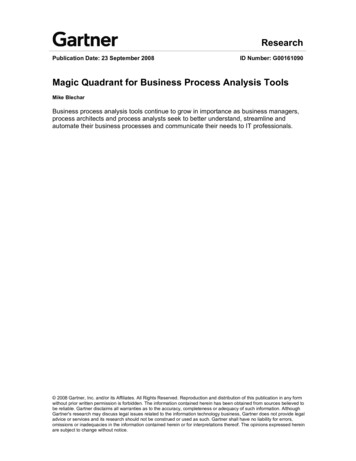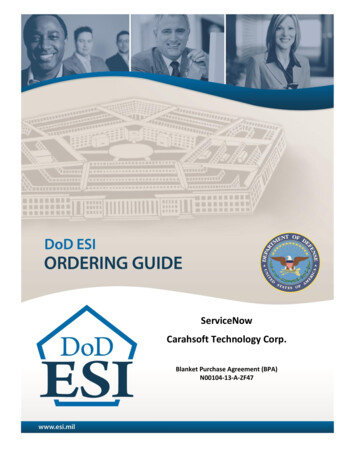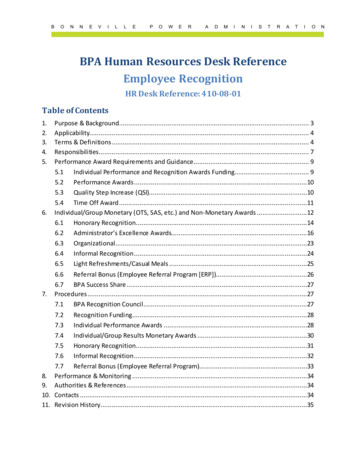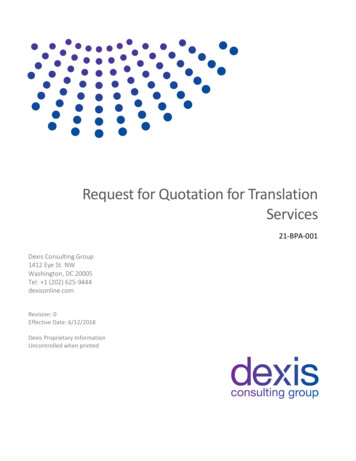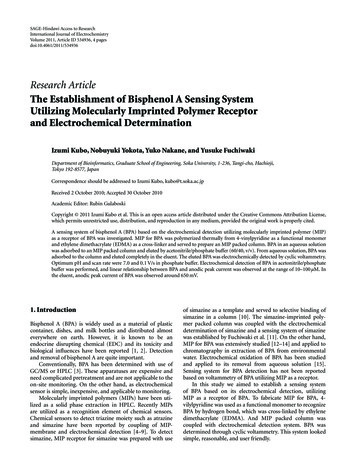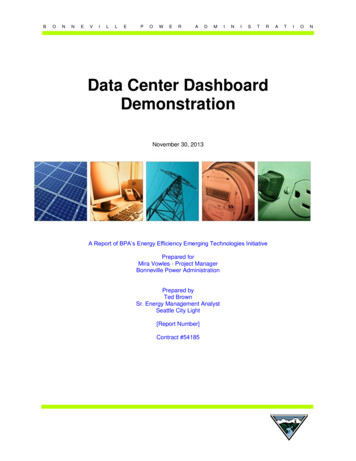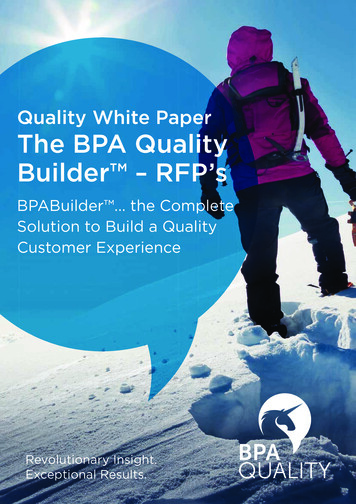
Transcription
everyone. Vendors will typically calculate the number of hours required toconduct your requested work in, the overall anticipated cost should be the same with all three methods. However,in the delivery of each method, there are cost advantages and disadvantages of each:Cost Per Unit – This quote will guarantee that you will always pay no more or less than the quoted price for theproduction level you are asking for. If you are asking for 1000 audits per month, you will know they will cost youthe same amount each month. However, this method typically only includes the audit. If you want the analyststo do something else it usually is at an additional cost or at the sacrifice of the number of audits they do.Cost Per Hour – This quote guarantees you a rate per hour, and you can contract for a certain number of hourswithout limitation to the activities that you can request your vendor to conduct they are your hours to spend.However, your “per audit” cost can fluctuate with efficiency or inefficiency of each one of those hours. Thismethod has the greatest flexibility, but the widest variationCost Per Person – This method you are essentially paying for the full time equivalent of a person’s productivity.You will pay a set rate per person and have control over what they do on a daily basis. However, like cost perhour, you end up paying for any inefficiency. If you use this model, make sure to set minimum expectations onproductivity.Training Cost – What is the vendors charge for training per hour, per person? Also, make sure you identify costsfor recursive or turnover training, if any. It is also wise to identify how the training is intended to be carried out andover what timeline.Building an Effective RFP Document for Quality Monitoring3
Set Up Fees – every vendor will have an upfront cost of setting you up as a client, and sometimes this means thereis an upfront set up fee involved. Usually, these fees are fair and required; however make sure you identify exactlywhat you are paying for in the set up charge so you can avoid future charges for costs that pop up after the fact.Management Fees – Identify what level of management support you need vs. what is being proposed. If yourequire a dedicated manager, ask for one and find out the cost. Some vendors will include this in their auditing cost,others will separate it. Either way, find out where it is and how much it is.Technology Fees – Identify if there are any costs for the use of technology from the vendor, the set up andmanagement of connections to call recording systems, the storage of data and or audio files or any other technicalaspect to your business request. Some companies have flat fees, others are a pay as you go model.Other Fees – make sure you ask an open ended question such as “are there any other fees for services or activitiesnot explicitly stated in this RFP?” This will open up the discussion for how to handle those activities when theycome up after award and during implementation. Nobody likes to come back and ask for more money when itwasn’t anticipated, so proper identification of those fees up front is important.What is included and What is not? – Make sure you ask for a documented list of items of what is included in thecharges and what is not included. For example, if you require calibration sessions once per week, is that includedfee, or extra? What is the charge if you want to move to two calls per week? Clarifying these small details will avoidfuture conflict and keep your vendor relationship healthy and honest.Experience and History – have the vendor describe to you their experience and history as a provider of theseservices. Tenure in the industry and experience with projects similar to yours can be important factors in choosingthe right vendor.Client Profile – while many client identities are confidential, ask the vendor to provide a profile of the types ofclients and services they have provided. Ideal vendors either have a wide array of experience in multiple industries,or long standing presence in the industry you are currently in. Also look for the vendor to identify companies orclients that they no longer do business with and identify the reasons why.Services and Capabilities – sometimes there are services and capabilities available that you didn’t know about andwould be helpful to achieve your goals. Have the vendor provide you with a comprehensive list of their services andspecial capabilities (i.e. language, programming, call recording, etc.)Financials and Legal – not required for all RFP’s, but it is good to do business with a vendor who is financiallystable. You want to see long standing profitability, ownership breakdown, growth rates, location of the business,hours of operation and perhaps most importantly, you’d like to do business with a company who has a wide arrayof clients and does not depend on one large contract. Additionally, you will need to know their status on all themajors, i.e. EOE or minority owned business, and you will need to know if this company is involved with any currentlitigation that could impact the business.References – get references from as many existing or past customers of the vendor as possible, and call them. Askthose references what they like and do not like about the vendor and their opinion of them as a whole. Ask them ifthey would use the vendor on a project such as yours.Technology – have the vendors clearly outline and demonstrate their technology, the advantages, and theprocess and make sure they outline how it would work to meet your goals. Make sure you get a full capabilitydemonstration and if allowed, access to a demonstration version of their tools.Reporting and Data Analysis – have the vendors provide to you the scope of reporting they will provide. Moreimportantly, have them identify how this reporting would be used to improve your contact center. Finally, identifywhat other Data Analysis the vendor intends to do will they simply produce the reports, or will they analyze thedata and find things for you?Building an Effective RFP Document for Quality Monitoring4
Business Process – have the vendors clearly outline how they do business, what makes them different and howthey would achieve your goals. Make sure they address the goals you laid out in your RFP goal statement. Askthem to describe how their services would benefit your organization and the intended effect.Management Qualifications – don’t be afraid to ask for the experience and background of the key people in thevendor organization. Make sure you are dealing with seasoned professionals for the work you are contractingand get the vendor to identify who those people are. If the vendor needs to hire people to meet your RFPrequirements, have them establish a template for qualifications for those people.Analyst Profile – find out who the people are that will be doing the work their qualifications, their location, howthey are trained and managed on a day to day basis. If the vendor does not currently have analysts that meetyour requirements, that doesn’t mean they can’t hire appropriately establish the requirement and have the vendoridentify how they would get them trained.Meet the People – ask the vendors to meet and greet with the people you will be working with. This business is arelationship driven business and if your Quality teams can’t work together well then you are throwing money outthe window.Timelines – ask how long it will take the vendor to ramp up and deliver. Identify the IT setup time, the training timeand the amount of time needed until the analysts are up to full speed in production.It is normal for a new vendor to adjust to your business, so make sure you agree to an acceptable time line.Security and Legal – have the vendors outline their security of information features. Identify if they have achievedany certifications, such as PCI (Payment Card Industry) specifications for the management and storage of personalor audit data. If available, have your IT team provide an outline of requirements for access to your network to makesure the vendor knows what is expected of them. Many companies have specific requirements that certain vendorsare not capable of meeting based on the operational model used. Based on that outline, the vendor can provideyou with the cost of establishing and meeting those requirements.Disaster Recovery – while not always relevant it’s important to choose a vendor who is not at risk of losing all ofyour data or who may be subject to extended periods of downtime due to natural disasters. While any event isunpredictable, choose a vendor that has a thought out plan and redundancy in critical areas of operations.Insurances – if required, have the vendor provide copies of insurance coverage’s and or the names and policynumbers of those coverage’s to meet your needs.About BPAWith over 20 years experience, over 100 different clients, and millions ofobservations made worldwide, BPA International has the experience, knowledgeand ingenuity to help you achieve the highest possible Call Center QualityCustomer Experience. BPA is the most experienced and qualified provider ofContact Center Quality Services worldwide.Visit us today at www.bpaquality.com or contact us at 516.295.3620 in North orSouth America, or 44 (0) 1404 44004 in the UK, Europe, Asia, Africa or Australia.Building an Effective RFP Document for Quality Monitoring5
A Request for Proposal (RFP) or Request for Quote (RFQ) is a formal process that companies use to put out outsourced work for bid amongst competing providers. RFP's and RFQ's are common practice in the contact center industry. Typically, an organization will release a RFP or RFQ requesting prospective suppliers to submit



